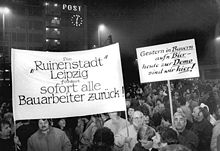- Monday demonstrations in East Germany
-
The Monday demonstrations in East Germany in 1989 and 1990 (German: Montagsdemonstrationen) were a series of peaceful political protests against the authoritarian communist government of the German Democratic Republic (GDR) that took place every Monday evening.
Contents
Overview
In Leipzig the demonstrations began on 4 September 1989 after the weekly Friedensgebet (prayer for peace) in the Nikolaikirche with parson Christian Führer, and eventually filled the nearby downtown Karl Marx Square (today known again as Augustusplatz). Safe in the knowledge that the Lutheran Church supported their resistance, many dissatisfied East German citizens gathered in the court of the church, and non-violent demonstrations began in order to demand rights such as the freedom to travel to foreign countries and to elect a democratic government.
Informed by (West German) television and friends about the events, people in other East German cities begun repeating the Leipzig demonstration, meeting at city squares on Monday evenings. A major turning point was the events in the West Germany Embassy of Prague, where thousands of East Germans had fled to in September, living there in conditions reminiscent of the Third World. Hans-Dietrich Genscher had negotiated an agreement that allowed them to travel to the West, in trains that had to pass first through the GDR. The speech of Hans-Dietrich Genscher from the balcony was interrupted by a very emotional reaction to his announcement. When the trains passed Dresden central station in early October, police forces had to stop people from trying to jump on the trains.
By 9 October 1989, just after the 40th anniversary celebrations of the GDR, what had begun as a few hundred gatherers at the Nikolaikirche had swelled to more than 70,000 (out of the city's population of 500,000), all united in peaceful opposition to the regime. The most famous chant became Wir sind das Volk! - "We are the people!", reminding their leaders that a democratic republic has to be ruled by the people, not by an undemocratic party claiming to represent them.
Although some demonstrators were arrested, the threat of large-scale intervention by security forces never materialised as local leaders (SED party leader Helmut Hackenberg and Generalmajor Gerhard Straßenburg of the armed police), without precise orders from East Berlin and surprised by the unexpected high number of citizens, shied away from causing a possible massacre, ordering the retreat of their forces. Later, Egon Krenz claimed it was he who gave the order not to intervene.
The next week, in Leipzig on 16 October 1989, 120,000 showed up, with military units again being held on stand-by in the vicinity. The next week, the number more than doubled to 320,000. This pressure led to the Fall of the Berlin Wall on 9 November 1989, marking the imminent fall of the socialist GDR regime.
The demonstrations eventually ended in March 1990, around the time of the first free multi-party elections on all-GDR level, for the Volkskammer parliament that paved the way to German reunification.
Years later, Monday demonstrations were also held in the early and mid-2000s as a protest against the Iraq war, against social security changes (Hartz IV), and since the fall of 2009 against the Stuttgart 21 project.
See also
- Uprising of 1953 in East Germany
- Alexanderplatz demonstration
- Revolutions of 1989
- History of the German Democratic Republic
Literature
- Wolfgang Schneider et al. (Hrsg.): Leipziger Demontagebuch. Demo – Montag – Tagebuch – Demontage, Leipzig/Weimar: Gustav Kiepenheuer 1990
- Norbert Heber: Keine Gewalt! Der friedliche Weg zur Demokratie – eine Chronologie in Bildern, Berlin: Verbum 1990
- Jetzt oder nie – Demokratie. Leipziger Herbst 1989, Leipzig: C. Bertelsmann 1989
- Ekkehard Kuhn: Der Tag der Entscheidung. Leipzig, 9. Oktober 1989, Berlin: Ullstein 1992
- Karl Czok: Nikolaikirche – offen für alle. Eine Gemeinde im Zentrum der Wende, Leipzig: Evangelische Verlagsanstalt 1999
- Tobias Hollitzer: Der friedliche Verlauf des 9. Oktober 1989 in Leipzig – Kapitulation oder Reformbereitschaft? Vorgeschichte, Verlauf und Nachwirkung, in: Günther Heydemann, Gunther Mai und Werner Müller (Hrsg.) Revolution und Transformation in der DDR 1989/90, Berlin: Duncker & Humblot 1999, S. 247–288
- Martin Jankowski: „Rabet oder Das Verschwinden einer Himmelsrichtung“. Roman. München: via verbis, 1999, ISBN 3933902037
- Thomas Küttler , Jean Curt Röder (Hrsg.): "Die Wende in Plauen", Plauen: Vogtländischer Heimatverlag Neupert Plauen 1991
- Martin Jankowski: Der Tag, der Deutschland veränderte - 9. Oktober 1989. Evangelische Verlagsanstalt, Leipzig 2007, ISBN 978-3-374-02506-0
- Schmemann, Serge, Upheaval in the East; Leipzig Marchers Tiptoe Around Reunification New York Times, December 19, 1989.
External links
Categories:- Die Wende
- History of East Germany
- Protests in Germany
- 1989 in East Germany
- 1990 in East Germany
Wikimedia Foundation. 2010.


